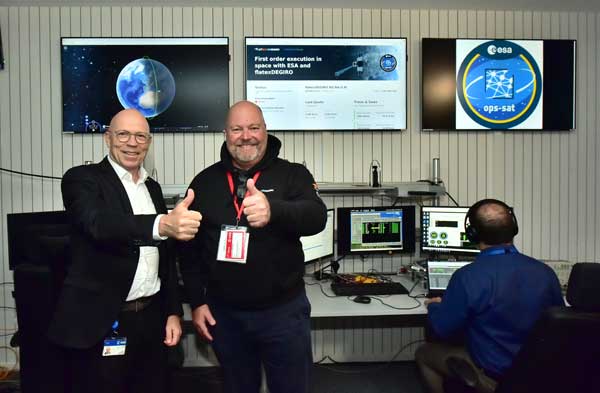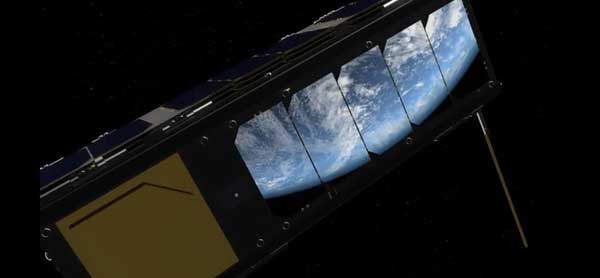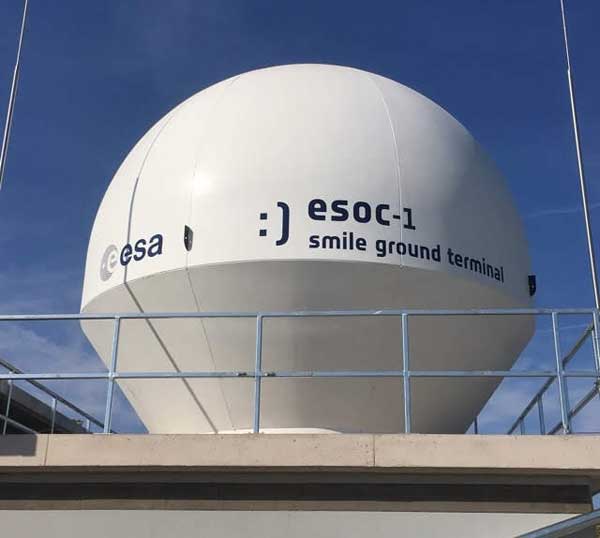
Trading Space: ESA Bolsters European Business (Image Credit: SNN)
DARMSTADT, Germany (ESA PR) — Yesterday, ESA’s orbiting laboratory, OPS-SAT, hosted the first-ever stock trade in space. The successful experiment required developers at Europe’s leading online broker flatexDEGIRO to think far outside of the box and adapt their software to the technical demands and constrained bandwidth found on an orbiting platform at 500 km altitude.
The experiment provided a unique opportunity to test how to improve the reliability, storage efficiency, communication and security of financial transactions, some of the fundamental requirements for any trading business aiming to compete on a global stage.
First trade in orbit
On 30 September, flatexDEGIRO used ESA’s OPS-SAT satellite to trade 100 of their own shares, which sold for about €200.00. The transaction, miniscule in comparison to the billions of euros traded every day through computers, networks and connections on Earth, was the first of its kind to happen in orbit.

The trade execution was monitored by a team at ESA’s ESOC mission control centre in Darmstadt, Germany, although the flexibility of the open-platform OPS-SAT laboratory meant that it could have been done from anywhere.
“An online brokerage and its technical infrastructure are designed to make transactions simple and easy for customers, but they are exposed to daily attacks from hackers, latency issues and other technical challenges,” said Frank Niehage, CEO of flatexDEGIRO.
“For our technical teams, working with ESA’s OPS-SAT platform allowed us to fly an experiment that helps expand our knowledge and expertise and increase flatexDEGIRO’s competitive edge to the benefit of our customers.”
“We also aimed to gain insights into the feasibility of any future satellite-supported trading system in a practical test of securities trading.”
Surprising new use for ESA’s open platform
ESA’s free-to-use OPS-SAT is specifically designed to trial and test innovative new software from European companies and other entities, including universities, research institutes and government agencies – who often find it a challenge to gain flight heritage for their newly developed applications and tools.
OPS-SAT: ESA’s flying lab, open to all
OPS-SAT, launched in December 2019, is a cubesat just 30 cm tall but it features powerful onboard systems and can host a range of experiments, spanning artificial intelligence, advanced communication protocols and compression techniques, software-defined radio, optical communication, advanced autonomous planning, web services in space and much else.
To date, over 200 experimenters – most submitted by start-ups and small-to-medium enterprises – have flown their software in orbit.
“Having a trading platform come on board OPS-SAT was a bit unexpected. But when you think about it, it makes perfect sense,” says ESA’s David Evans, OPS-SAT Mission Manager.

“Executing stock trades and flying a satellite present many similar challenges, like the high cost of making a mistake, how to keep systems running around the clock and protection from cyberattack while remaining open to the Internet. Bringing these two worlds together is a unique and fruitful exchange.”
What are space agencies for?

As space now underpins an enormous slice of Europe’s economy, while also becoming more accessible than ever before, initiatives like OPS-SAT illustrate ESA’s role – and the changing role of space agencies more generally – to enable the development of innovative new technologies, support businesses and lead the way to foster the commercialisation of space.
Agencies’ abilities to enable businesses to experiment and take risks shows what is possible in space, while also supporting new economic models and setting standards for responsible and sustainable spaceflight.
– Advertisement –








